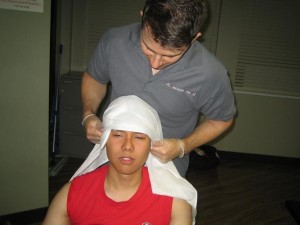First Aid Classes – Bandages / Dressings
Dressings and bandages are very important and are a big part in workplace approved

Training. They are applied to wounds in order to protect them from infection, and sometimes to apply pressure to control bleeding.
First Aid Classes – Dressings
Where possible, a sterile dressing should be used but if this is not available, a clean non-fluffy material could be used. Adhesive dressings can be used on small cuts and grazes but the adhesive should not be applied to any damaged skin. Dressings should always be larger than the wound they are covering and should be held by the edges to keep them as clean and aseptic as possible.
St Mark James First Aid manual says disposable gloves should always be worn if they are available, again to prevent the risk of infection.
Dressings can be used to maintain pressure over a bleeding wound. If the wound bleeds through the dressing, you should apply a second dressing on top. If the bleeding then seeps through again, you should redress the wound and ensure the pressure is concentrated onto the site of the bleeding.
Improvised dressings could be a section of material, cloth or scarf folded into a pad and placed on the wound. This could then be bandaged around and tied in a knot to secure.
When applying a cold compress to a patient, you could use a cold pad, or an ice pack. A cold pad could be any material soaked in very cold water, wrung out and folded to apply onto the injury. This method will need the pad to be re-soaked with cold water every 3-5 minutes to maintain the cold temperature. An ice pack consists of ice cubes, crushed ice, or frozen vegetables in a plastic bag. This should then be covered with a cloth in order to protect the skin it is being applied to from any cold burns and it mustn’t be used for longer than 10 minutes.
First Aid Classes – Bandages
Bandages can be used to secure dressings, control bleeding and support, immobilise or reduce swelling in limbs and injured body parts.
Bandages should be applied firmly but First Aid Classes tell you to ensure they are not too tight that they restrict blood flow. When you bandage try to leave toes or fingers visible. You can then check circulation by pinching them to check the capillary refill time. The patients circulation should be checked regularly because an injury may swell and therefore the bandage could become too tight as the inflammation develops.
First Aid Classes – Improvising Slings
If you do not have a triangular bandage available for a sling, you can improvise effective solutions by using items of clothing. The bottom of the patients jacket can be turned up and secured to the breast of the jacket with a safety pin, supporting the injured arm within it. An even simpler solution is tucking the hand of the injured arm into a gap created by unbuttoning one hole in a jacket and resting their wrist on the next button beneath it. A safety pin can also be used to pin the cuff of a long sleeved shirt to the breast on the opposite side of the injured arm to elevate it and keep the arm raised. And a final suggestion is using a belt, tie, braces or tights to make a collar and cuff support sling. Do this by making a large loop from the item, and hang this over the patients head like a necklace. Then twist the front to make a small loop for the hand of the injured arm to rest in. All of these improvised suggestions are taken from workplace approved First Aid manual and are very useful if you have no first aid equipment with you.
REFERENCES
First Aid Manual (The Authorised Manual of St. John Ambulance, St Andrew’s Ambulance Association and the British workplace approved), 2006.
